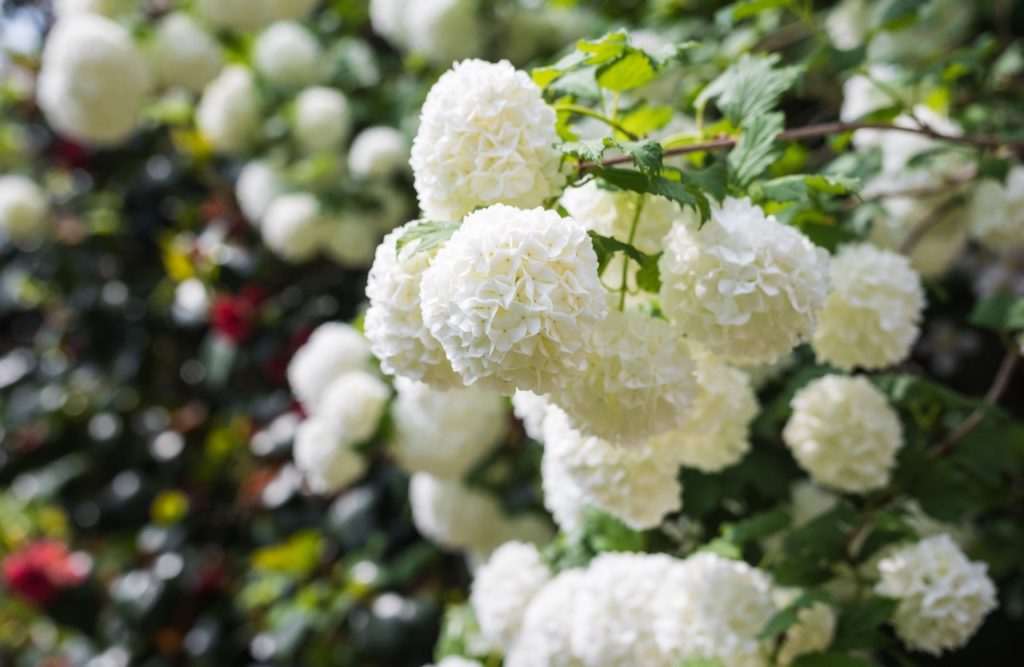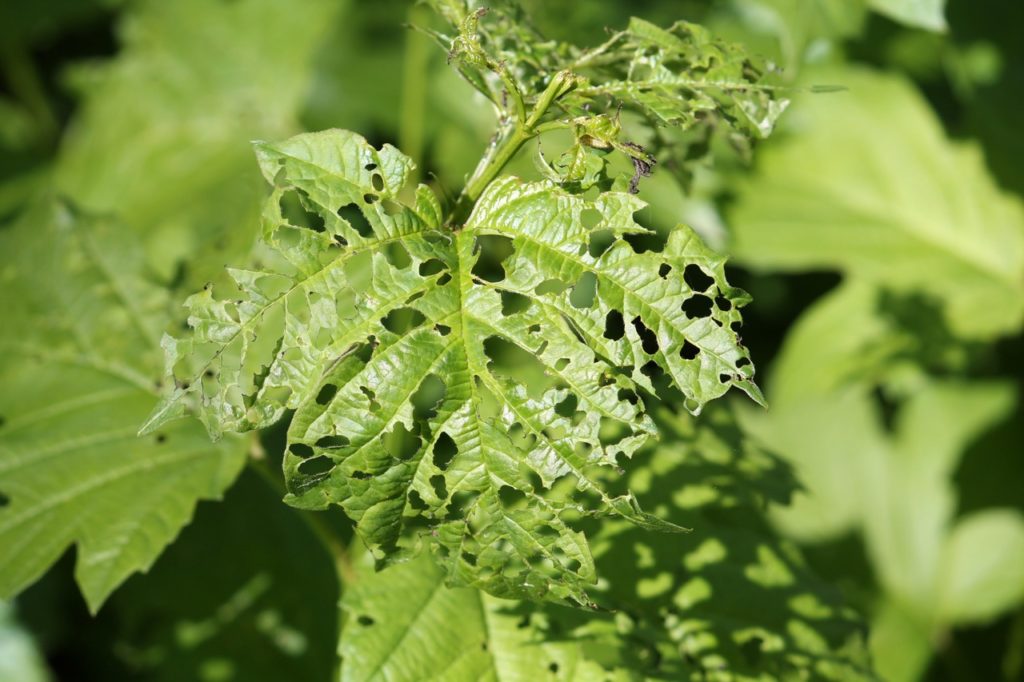SHRUBS > VIBURNUM > OPULUS > ROSEUM

Elizabeth is a Permaculture Garden Designer, Sustainability Consultant and Professional Writer, working as an advocate for positive change. She graduated from the University of St. Andrews with an MA in English and Philosophy and obtained a Diploma in Applied Permaculture Design from the Permaculture Association.
Reviewed By COLIN SKELLY

Colin is a Horticulturist and Horticultural Consultant with experience in a range of practical and managerial roles across heritage, commercial and public horticulture. He holds the Royal Horticultural Society’s Master of Horticulture award and has a particular interest in horticultural ecology and naturalistic planting for habitat and climate resilience.
VIBURNUM GUIDES
Viburnum opulus ‘Roseum’ is a sterile cultivar with beautiful spring blooms that are not followed by the usual red berries.
Like other guelder roses, it is prized not only for its snowball flowers, but also for its maple-like leaves, which turn red in autumn.
The blooms open to a light green shade which fades to white and then sometimes ages with a slight pinky blush.
The flowering heads are well-loved and often used in flower arrangements of cut flowers.
Overview
| Botanical Name | Viburnum opulus ‘Roseum’ |
| Common Name(s) | Red guelder rose |
| Plant Type | Shrub |
| Native Area | Europe, North Africa, Central Asia |
| Hardiness Rating | H6 |
| Foliage | Deciduous |
| Flowers | Dense clusters of creamy white flowers that are sterile |
| When To Plant | September to November |
| When To Prune | May to June |
Sunlight
Preferred
Full Shade, Full Sun or Partial Shade
Exposure
Exposed or Sheltered
Size
Height
3 – 4M
Spread
3 – 4M
Bloom Time
Spring
Soil
Preferred
Most fertile soils
Moisture
Moist but well-drained
pH
Any
Also known as ‘Red Guelder Rose’ or ‘Red Snowball Tree’, this sterile cultivar of V. opulus is a deciduous shrub.

It can be used for informal hedgerows or screening, in a woodland garden scheme, or as a stand-alone specimen in a wide range of settings.
How To Grow V. opulus ‘Roseum’
This is a sterile cultivar, so seeds will not form.
It can be purchased as a young shrub from garden centres or plant nurseries and online.
However, if someone you know has one of these shrubs in their garden, you could save money and make an eco-friendly choice by propagating a new plant by taking cuttings (more on this below).
Planting Guidelines
The best time to plant V. opulus ‘Roseum’ is in the autumn, between September and November, but you can also plant it in early spring.
The great news is that these plants can work well in a wide range of settings, sunlight levels and soils, so there is quite a lot of flexibility about where you might place one.

Once you have decided on a position, simply make a generous planting hole and place the shrub into it.
Fill in the soil back around the base so that the plant sits at the same level it was at in its previous pot or location.
Water it in well, then spread an organic mulch around the base, taking care not to mound the mulch around the base of the shrub.
Red Guelder Rose Care
This is a fantastic, unfussy and low-maintenance plant.

The only thing to remember is that this can turn into a rather large shrub, up to around 3-4m in height and width, so make sure that you have space for it in your garden if you do not plan on pruning it heavily.
Aspect & Light
Viburnum opulus is a woodland plant and grows best in light, dappled shade, but this shrub will flower more abundantly in full sun, though it can also tolerate deeper shade.
Soil Requirements
This shrub can grow well in almost any soil type, as long as it is moderately fertile, humus-rich and does not become waterlogged or compacted.

Moist but well-drained conditions are required.
Mulching around the plant annually in spring can help keep the soil healthy and ensure good levels of organic matter in the soil.
Container Growing
It is possible to prune extensively and keep these relatively fast-growing shrubs smaller, which means you can grow these shrubs in pots.
However, their fast rate of growth and larger natural size means that they may not be the best choice for container growing.
You may like to consider a dwarf hydrangea instead, for similar flowers but a more controllable habit and form.
Pruning
V. opulus ‘Roseum’ is in RHS pruning group 8 and should not require extensive cutting back unless grown as part of a hedge or hedgerow.1Shrubs: pruning evergreens. (n.d.-b). Royal Horticultural Society. Retrieved March 27, 2023, from https://www.rhs.org.uk/plants/types/shrubs/evergreen-pruning-guide
Light pruning (to remove dead, damaged or diseased material) should be undertaken immediately after flowering.
However, while it does not need to be pruned much – this shrub can tolerate hard renovation pruning if required.
Many gardeners choose to take out some branches to lift the plant and allow for decorative under-storey planting in a woodland border style scheme.
“I grow a guelder rose in a quite narrow space and remove 2-3 of the oldest branches every year after flowering,” Colin Skelly, a Horticulturist and Consultant, explains.
“This keeps the size relatively compact and allows underplanting to flourish around it.”
Propagating
You can propagate guelder roses from softwood or semi-hardwood cuttings.
Softwood cuttings are taken in the spring and early summer and are soft, flexible stems of new growth which should root readily.
Semi-ripe cuttings are taken in late summer or early autumn.
Common Problems
This is usually a very easy plant to grow and care for, with few incidences of serious problems or diseases.

Although aphids and viburnum beetle may sometimes become a problem, these are usually remedied relatively easily in an organic garden – typically by attracting natural predators and creating a natural balance.
FAQs
What Is The Growth Rate Of V. opulus?
This is a fairly fast-growing shrub.
How Big Does V. opulus Grow?
Usually between 3-4m in height and width, though it can be pruned to restrict its size and spread – and it is tolerant of hard pruning where it has become overgrown.
Can V. opulus Grow In Shade?
Yes, although, as mentioned above, it will not flower as abundantly when grown in the shade as it will when grown in full sun.
References
- 1Shrubs: pruning evergreens. (n.d.-b). Royal Horticultural Society. Retrieved March 27, 2023, from https://www.rhs.org.uk/plants/types/shrubs/evergreen-pruning-guide

